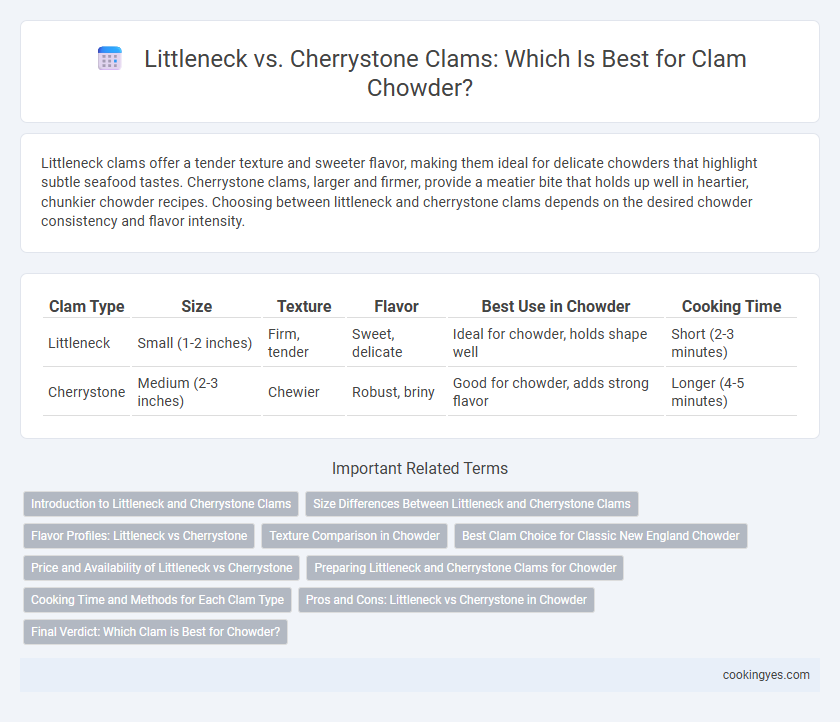Littleneck clams offer a tender texture and sweeter flavor, making them ideal for delicate chowders that highlight subtle seafood tastes. Cherrystone clams, larger and firmer, provide a meatier bite that holds up well in heartier, chunkier chowder recipes. Choosing between littleneck and cherrystone clams depends on the desired chowder consistency and flavor intensity.
Table of Comparison
| Clam Type | Size | Texture | Flavor | Best Use in Chowder | Cooking Time |
|---|---|---|---|---|---|
| Littleneck | Small (1-2 inches) | Firm, tender | Sweet, delicate | Ideal for chowder, holds shape well | Short (2-3 minutes) |
| Cherrystone | Medium (2-3 inches) | Chewier | Robust, briny | Good for chowder, adds strong flavor | Longer (4-5 minutes) |
Introduction to Littleneck and Cherrystone Clams
Littleneck clams, typically smaller and more tender, are prized for chowder due to their sweet, delicate flavor and quick cooking time. Cherrystone clams are larger, with a firmer texture and a slightly brinier taste, providing a heartier bite in chowder. Both varieties bring distinct textures and flavors, making them popular choices depending on the desired chowder consistency and taste intensity.
Size Differences Between Littleneck and Cherrystone Clams
Littleneck clams typically measure 1 to 2 inches in diameter, making them smaller and more tender compared to Cherrystone clams, which range from 2 to 3 inches. The size difference directly affects cooking time; Littlenecks cook quickly and are ideal for delicate chowders, while Cherrystones require longer cooking to soften. This distinction influences the clam chowder's texture and flavor, with Littlenecks offering a sweeter taste and Cherrystones providing a more robust, hearty bite.
Flavor Profiles: Littleneck vs Cherrystone
Littleneck clams offer a sweet, tender texture and a briny, delicate flavor that enhances chowder without overpowering other ingredients. Cherrystone clams provide a firmer, chewier bite with a more robust, slightly salty taste that adds depth and richness to the soup. Choosing between littleneck and cherrystone clams for chowder depends on whether a milder, more subtle clam flavor or a heartier, pronounced seafood presence is desired.
Texture Comparison in Chowder
Littleneck clams offer a tender, slightly chewy texture that blends seamlessly into chowder, creating a smooth bite with subtle firmness. Cherrystone clams provide a denser, meatier texture that stands out more distinctly in chowder, giving a heartier, more substantial clam presence. Choosing Littlenecks ensures a delicate mouthfeel, while Cherrystones contribute a robust chew that enhances the chowder's overall texture profile.
Best Clam Choice for Classic New England Chowder
Littleneck clams, with their tender texture and mild briny flavor, are the best clam choice for classic New England chowder, offering a delicate yet distinct bite that complements the creamy base. Cherrystone clams are larger and meatier, which can create a heartier chowder but may overpower the dish's subtle balance. For an authentic chowder experience, littlenecks provide the ideal sweetness and tenderness that enhance the traditional seafood profile without compromising the chowder's smooth texture.
Price and Availability of Littleneck vs Cherrystone
Littleneck clams are generally more affordable and widely available than cherrystone clams, making them a popular choice for chowder recipes. Cherrystone clams tend to be larger and pricier, often reserved for dishes where clam size and texture are emphasized. For budget-conscious cooks or those seeking consistent supply, littlenecks offer a practical and cost-effective option without compromising flavor.
Preparing Littleneck and Cherrystone Clams for Chowder
Littleneck clams, smaller and more tender, require thorough rinsing under cold water to remove sand before chopping them finely for chowder, ensuring a delicate texture and subtle briny flavor. Cherrystone clams, larger and meatier, benefit from steaming until just opened to preserve their robust taste, followed by careful removal of the meat, which adds a chewier consistency to the chowder. Both clam types should be purged in saltwater to eliminate grit, enhancing the purity and richness of the chowder's seafood essence.
Cooking Time and Methods for Each Clam Type
Littleneck clams, smaller and more tender, cook quickly within 3-5 minutes, making them ideal for recipes requiring brief steaming or simmering to preserve their delicate texture. Cherrystone clams, larger and meatier, benefit from longer cooking times of 7-10 minutes to fully tenderize the tougher meat, often requiring blanching before adding to chowder to ensure even cooking. Choosing the right clam type affects chowder preparation, as littlenecks suit quick-cooking methods while cherrystones need longer heat exposure to release rich flavors without becoming chewy.
Pros and Cons: Littleneck vs Cherrystone in Chowder
Littleneck clams offer a tender texture and sweet, briny flavor ideal for chowder, enhancing its delicate taste without overpowering other ingredients. Cherrystone clams, being larger and meatier, provide a heartier chew and robust clam flavor but can sometimes result in a tougher bite if overcooked. Choosing between littleneck and cherrystone clams depends on the desired chowder texture--littlenecks for subtlety and tenderness, cherrystones for a pronounced, chewy clam presence.
Final Verdict: Which Clam is Best for Chowder?
Littleneck clams provide a tender texture and mild, sweet flavor that enhances chowder without overpowering other ingredients. Cherrystone clams offer a chewier bite and stronger briny taste, which can add depth to heartier chowders but may dominate subtle flavors. Choosing littlenecks is generally best for a balanced, classic chowder experience.
Littleneck vs Cherrystone for chowder Infographic

 cookingyes.com
cookingyes.com